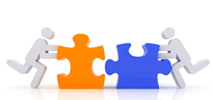Interoperable systems broaden choice and open up new perspectives for researchers, governments and citizens across a spectrum of disciplines and domains. Interoperability is key to taking Digital Libraries to the next level, enabling wider collaboration across the board and ensuring that a broader spectrum of resources are available to a wider range of people whether for simple consumption or to enhance research activities. But interoperability is a complex, multi-layered and context-specific concept, encompassing different levels along a multi-dimensional spectrum ranging from organisational to technological aspects. It is a “hard and dirty job”.
DL.org is the first initiative to investigate interoperability from an all-encompassing perspective by harnessing leading figures in the DL space globally, investigating six core concepts characterising a Digital Library.The output is an innovative Digital Library Technological and Methodological Cookbook with a portfolio of best practices and pattern solutions to common issues faced when developing large-scale interoperable digital library systems. A key facet of the Cookbook is the interoperability framework that can be used to systematically characterise diverse facets linked to the interoperability challenge as well as current and emerging solutions and approaches. The Cookbook is designed to facilitate the assessment and selection of the solutions presented, enabling professionals working towards interoperability to define and pursue the different steps involved.
How did we get there?
The investigation has taken as its starting point the IEEE Glossary, which defines interoperability as “the ability of two or more systems or components to exchange information and to use the information that has been exchanged” (Geraci, 1991). This definition highlights that to achieve interoperability between two entities (provider, consumer) two conditions must be satisfied:
- The two entities must be able to exchange information.
- The consumer entity must be able to effectively use the exchanged information, that is, the consumer must be able to perform the tasks it is willing to do by relying on the exchanged information.
DL.org has addressed the multiple digital library interoperability levels, along the classification of the European Interoperability Framework (EIF):
- Organisational interoperability: defining business goals, modelling business processes and bringing about the collaboration of digital library (and their underlying systems) institutions that wish to exchange resources and may have different internal structures and processes. Moreover, organisational interoperability aims at addressing the requirements of the user community by making resources available, easily identifiable, accessible and user-oriented.
- Semantic interoperability: ensuring that the precise meaning of exchanged digital library resources is understandable by any other digital library “system” that was not initially developed to deal with it. Semantic interoperability enables systems to combine received resources with other resources and to process (exploit) it in a meaningful manner.
- Technical interoperability: technical issues of linking computer systems and services implementing the digital libraries and their resources.
To provide feedback on the Cookbook, contact cookbook@dlorg.eu.

